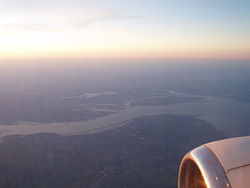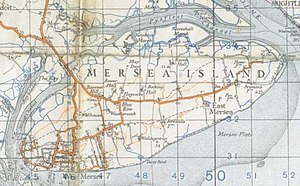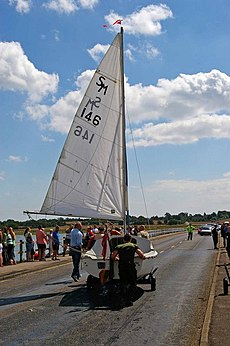Mersea Island
| Mersea Island | |
 Mersea Island (centre right) from the air | |
|---|---|
| Location | |
| Grid reference: | TM060150 |
| Area: | 7 square miles |
| Data | |
| Population: | 7,000 |
Mersea Island (formerly Mersey Island) is the most easterly inhabited island in the United Kingdom apart from Great Britain itself. It stands just off the coast of mainland Essex, to which it is joined by a tidal causeway. Its one town is West Mersea and its one village East Mersea. There is also a hamlet, Barrow Hill, to the north of West Mersea.
The island is 9 miles southeast of Colchester, lying in the estuary area of the River Blackwater and River Colne and has an area of around 7 square miles.[1] The name 'Mersea' is derived from the Old English meresieg meaning "sea island".
Geography
The island lies on the ragged coast of Essex against the North Sea; a coastline of low land where rivermouths and tidal creeks create a vast number of islands, flats and sandbanks. Mersea Island is where the River Colne out of Colchester from the north and the Blackwater from the south enter the North Sea.
The isle is separated from mainland Great Britain by a narrow channel and is joined to Great Britain by a single causeway bearing the B1025 road out of West Mersea. The causeway is known as The Strood, which was built in the Anglo-Saxon period. It is underwater at the highest tides and tragedy has occurred when a driver has attempted to make the crossing at the wrong tide, and the tidal race around the island can be cruel and unforgiving.
Ray Island intervenes in the middle of the Strood Channel, though barely an island, joined as it is to the mainland by a marsh.
Separating the island from mainland Great Britain are the Pyefleet Channel and the Strood Channel (either side of the Strood). The north-western side of the island, overlooking the Pyefleet Channel, has long embankments against flooding.
Economy
The main industries on Mersea are farming, fishing, oyster gathering and servicing the leisure boating industry.
The island has its own newspapers, the Mersea Life and the Mersea Island Courier.
History

There is evidence of pre-Roman settlement on Mersea in the form of "red hills" which are evidence of Celtic salt workings. A large Romano-British round barrow near the Strood contained the remains of a cremated adult in a glass urn, within a lead casket,[2] now in the Castle Museum, Colchester. A large mosaic floor was found near West Mersea church.
The Anglo-Saxons built the church at West Mersea (St Peter & St Paul) which may have been founded as early as the 7th century. It was damaged by Norse raiders in 894 and rebuilt afterwards. A moat at East Mersea church (St Edmund, King & Martyr) is thought to be the remains of a Danish encampment.
The Strood causeway was also built by the Saxons; oak piles discovered in 1978 have been dated by dendrochronology to between 684 and 702.[3] By 950, there was a Benedictine Priory at West Mersea and land at West Mersea was granted to the Abbey of St Ouen in France by Edward the Confessor in 1046.[4]
The priory was finally dissolved in 1542. In the English Civil War, the Parliamentary Army built a blockhouse at East Mersea in 1648, with the aim of blockading the River Colne and the besieged town of Colchester. During the 16th and 17th centuries, Dutch and French settlers arrived on the island. Some locals supplemented their income from the oyster trade by smuggling.
A police officer for the island was appointed in 1844, and in 1871 a school was opened. The Reverend Sabine Baring Gould (author of "Onward Christian Soldiers" and of "Mehalah", a novel set in Mersea) was Rector of East Mersea from 1870-1881.[5] Mains water and sewerage were available by 1925. In Second World War, 2000 troops were stationed on the island to guard against invasion; the island was the Headquarters of the Royal Army Corps Motor Boat Company.[6] Two batteries of 4.7 inch guns were installed; one at East Mersea has been demolished and one at West Mersea, now a cafe.[7]
After the war, the island suffered from severe winter weather in 1947 which destroyed much of the oyster fishery, and from the North Sea flood of 1953. Since then the population has increased considerably however.[8][9]
Events

The Mersea Regatta is a week-long late summer festival of boat racing. The week of the festival changes each year depending on the tide tables - it is the last Saturday in August to have a high tide at around midday.
During the week, starting on Monday, there are races for many boat classes - from Optimists up to large yachts. The most celebrated race is the annual 'Round-the-Island' race in which about 200 dinghies attempt to sail all the way around the island, helped over the Strood by volunteers. These races usually take place in the Blackwater Estuary (also known as the Mersea Quarters).
The Grande Finale on the final Saturday includes harbour fun: short spectator inshore races, soot and flour fights on the water, the Greasy Pole, fireworks and the week's Awards Ceremony. During the day there is a plethora of street entertainment, hot dog vendors, ice-cream vans etc.
In the Greasy Pole event, contenders have to traverse a telegraph pole/mast covered in thick grease and extended out over the water from the deck of the Regatta hosting Thames sailing barge (similar to 'walking the plank'), retrieve the flag at the end and return to the boat with the flag in hand. Annually a handful of the 50 or so contenders get to the end of the pole and grab the flag (an accomplishment in itself!) but rarely more than one, if any, will bring it back to the Barge.[10]
Literature
The island is used as a setting for several works of Margery Allingham, such as Mystery Mile and The Mind Readers. Mehalah is a novel set in Mersea by Sabine Baring-Gould.
Other island nearby
Other Essex island nearby include:
Outside links
- The Mersea Community and Business Portal, west-mersea.co.uk
- Mersea Island Community Website
- Webcam of Mersea Island and The Strood, streamdays.com
References
- ↑ "Largest Islands of the United Kingdom". users.erols.com. http://users.erols.com/jcalder/UK.htm. Retrieved 2009-08-30.
- ↑ Mersea Museum
- ↑ http://cat.essex.ac.uk/reports/EAS-report-0023.pdf
- ↑ University of Essex
- ↑ Merseacofe.org
- ↑ Westmersea.org
- ↑ Essexcc.gov.uk
- ↑ Mersea Museum
- ↑ A Short History of Mersea, Elsie M Karbacz 1999, ISBN 0-9537322-0-7
- ↑ Mersearegatta.org.uk